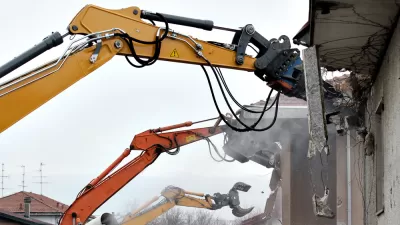Removing Detroit’s blight is highly emotional, and made more difficult by the lack of models for emulation. A recent editorial rejects the assumption that removing blight from over 100,000 vacant lots is sufficient to stimulate economic development.
After acknowledging that “[the] blight removal task force bankrolled by the federal government under the leadership of Gilbert’s Rock Ventures has set up an amazing process for mapping the city’s condition,” a recent editorial by John Gallagher pushes back on the argument that blight removal, by itself, will create economic opportunities in Detroit.
Maggie DeSantis, quoted in the article, invokes the eyeball test for the efficacy of blight removal in catalyzing economic development in Detroit: “If knocking down blight and clearing property was really the answer, then you’d already be seeing it.”
Gallagher goes on to raise the unanswered questions of Detroit’s current blight inventory and removal processes: “The short-term concerns focus on how demolition of tens of thousands of eyesore structures will take place in a short period of time. Will the debris be hauled away to landfills or dumped in the basements in a way that will create problems for future redevelopment? Will there be any attempt to salvage wood and other useful products to create a deconstruction industry in the city? Will city residents or outsiders get the jobs?”
Gallagher’s argument assumes that the ideas proposed by the Detroit Future City vision plan, which he describes as “innovative ways to repurpose urban land in the absence of development pressure,” are far from being actualized.
FULL STORY: John Gallagher: You tear down the blight in Detroit, but then what?

Americans May Be Stuck — But Why?
Americans are moving a lot less than they once did, and that is a problem. While Yoni Applebaum, in his highly-publicized article Stuck, gets the reasons badly wrong, it's still important to ask: why are we moving so much less than before?

Study: Maui’s Plan to Convert Vacation Rentals to Long-Term Housing Could Cause Nearly $1 Billion Economic Loss
The plan would reduce visitor accommodation by 25,% resulting in 1,900 jobs lost.

Using Old Oil and Gas Wells for Green Energy Storage
Penn State researchers have found that repurposing abandoned oil and gas wells for geothermal-assisted compressed-air energy storage can boost efficiency, reduce environmental risks, and support clean energy and job transitions.

San Diego Swaps Parking Lane for Kid-Friendly Mini Park
The block-long greenway will feature interactive play equipment and landscaping.

Tracking the Invisible: Methane Leaks From LA’s Neighborhood Oil Sites
Environmental advocates are using infrared technology to monitor and document methane leaks from neighborhood oil sites, filling regulatory gaps and pushing for stronger protections to safeguard community health and the climate.

Montana Bill Promotes Parking Reform
A bill before the Montana state senate would bar cities from requiring more than one parking spot per new housing unit.
Urban Design for Planners 1: Software Tools
This six-course series explores essential urban design concepts using open source software and equips planners with the tools they need to participate fully in the urban design process.
Planning for Universal Design
Learn the tools for implementing Universal Design in planning regulations.
Caltrans
Heyer Gruel & Associates PA
Institute for Housing and Urban Development Studies (IHS)
City of Grandview
Harvard GSD Executive Education
Salt Lake City
NYU Wagner Graduate School of Public Service
City of Cambridge, Maryland





























